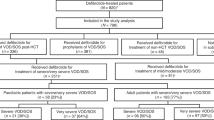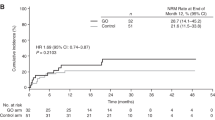Abstract
Gemtuzumab ozogamicin (GO) (Mylotarg, CMA-676) is a novel chemotherapeutic agent consisting of an anti-CD33 monoclonal antibody linked to calicheamicin, and is associated with a 30% response rate in patients with CD33-positive acute myeloid leukemia (AML) in first relapse. GO therapy has a 20% incidence of grade 3 or 4 hepatotoxicity, and has recently been associated with hepatic veno-occlusive disease (VOD). The efficacy and toxicity of GO in patients with AML who have relapsed after hematopoietic stem cell transplant (HSCT) is unknown, as this population was largely excluded from phase II studies. We reviewed the outcomes of eight consecutive patients with AML who received GO following relapse after HSCT. Two (25%) had responses to GO. One patient, who had had two previous HSCT and prior hyperbilirubinemia, developed severe VOD and died 14 days after GO therapy. The other seven patients did not meet diagnostic criteria for VOD. We conclude that GO can be safe and effective in patients who relapse following HSCT, but that caution is warranted in patients with multiple risk factors for VOD.
This is a preview of subscription content, access via your institution
Access options
Subscribe to this journal
Receive 12 print issues and online access
$259.00 per year
only $21.58 per issue
Buy this article
- Purchase on Springer Link
- Instant access to full article PDF
Prices may be subject to local taxes which are calculated during checkout
Similar content being viewed by others
References
Lowenberg B, Downing J, Burnett A . Acute myeloid leukemia New Engl J Med 1999 341: 1051 1062
Webb D . Management of relapsed acute myeloid leukaemia Br J Haematol 1999 106: 851 859
Levy V, Marjanovic Z, Vekhoff A et al. Relapse after autologous hematopoietic stem cell transplantation in acute myeloid leukemia, a single center experience over 13 years Am J Hematol 2000 64: 232 233
Dinndorf P, Andrews R, Benjamin D et al. Expression of normal myeloid–associated antigens by acute leukemia cells Blood 1986 67: 1048 1053
Sievers E, Appelbaum F, Speilberger R et al. Selective ablation of acute myeloid leukemia using antibody-targeted chemotherapy: a phase I study of an anti-CD33 calicheamicin immunoconjugate Blood 1999 93: 3678 3684
Sievers E, Larson R, Stadtmauer E et al. Efficacy and safety of gemtuzumab ozogamicin in patients with CD33-positive acute myeloid leukemia in first relapse J Clin Oncol 2001 19: 3244 3254
Carreras E, Bertz H, Arcese W et al. Incidence and outcome of hepatic veno-occlusive disease after blood or marrow transplantation: a prospective cohort study of the European Group for Blood and Marrow Transplantation Blood 1998 92: 3599 3604
Bearman S . Veno-occlusive disease of the liver Curr Opin Oncol 2000 12: 103 109
Richardson P, Guinan E . The pathology, diagnosis, and treatment of hepatic veno-occlusive disease: current status and novel approaches Br J Haematol 1999 107: 485 493
Carreras E . Veno-occlusive disease of the liver after hemopoietic cell transplantation Eur J Haematol 2000 64: 281 291
Bearman S, Lee J, Baron A et al. Treatment of hepatic venoocclusive disease with recombinant human tissue plasminogen activator and heparin in 42 marrow transplant patients Blood 1997 89: 1501 1506
Richardson P, Elias D, Krishnan A et al. Treatment of severe veno-occlusive disease with defibrotide: compassionate use results in efficacy without significant toxicity in a high risk population Blood 1998 4: 142 150
Barclay KL, Yeong ML . Actinomycin D associated hepatic veno-occlusive disease — a report of 2 cases Pathology 1994 26: 257 260
Ortega JA, Donaldson SS, Ivy SP et al. Venoocclusive disease of the liver after chemotherapy with vincristine, actinomycin D, and cyclophosphamide for the treatment of rhabdomyosarcoma Cancer 1997 79: 2435 2439
Gill RA, Onstad GR, Cardamone JM et al. Hepatic veno-occlusive disease caused by 6-thioguanine Ann Intern Med 1982 96: 58 60
Neumeister P, Eibl M, Zinke-Cerwenka W et al. Hepatic veno-occlusive disease in two patients with relapsed acute myeloid leukemia treated with anti-CD33 calicheamicin (CMA-676) immunoconjugate Ann Hematol 2001 80: 119 120
McDonald G, Hinds M, Fisher L et al. Veno-occlusive disease of the liver and multiorgan failure after bone marrow transplantation: a cohort study of 355 patients Ann Intern Med 1993 118: 255 267
Sievers E, Larson R, Estey E et al. Low incidence of hepatic veno-occlusive disease after treatment with gemtuzumab ozogamicin (Mylotarg, CMA-676): relationship to hematopoietic stem cell transplantation Blood 2000 96: 206b
Giles F, Kantarjian H, Kornblau S et al. Mylotarg (gemtuzumab ozogamicin) therapy is associated with hepatic venoocclusive disease in patients who have not received stem cell transplantation Cancer 2001 92: 406 413
Smith JW . Tolerability and side-effect profile of rhIL-11 Oncology 2000 14 (9 Suppl. 8): 41 47
Gordon MS, McCaskill-Stevens WJ, Battiato LA et al. A phase I trial of recombinant human interleukin-11 (neumega rhIL-11 growth factor) in women with breast cancer receiving chemotherapy Blood 1996 87: 3615 3624
Hasegawa S, Horibe K, Kawabe T et al. Veno-occlusive disease of the liver after allogeneic bone marrow transplantation in children with hematologic malignancies: incidence, onset time and risk factors Bone Marrow Transplant 1998 22: 1191 1197
Gilles J, Divon M, Bentolila E et al. Immunophenotypic characterization of human fetal liver hematopoietic stem cells during the midtrimester of gestation Am J Obstet Gynecol 1997 177: 619 625
Blakolmer K, Jaskiewicz K, Dunsford H et al. Hematopoietic stem cell markers are expressed by ductal plate and bile duct cells in developing human liver Hepatology 1995 21: 1510 1516
Muench M, Cupp J, Polakoff J et al. Expression of CD33, CD38, and HLA-DR on CD34+ human fetal liver progenitors with a high proliferative potential Blood 1994 83: 3170 3181
Favaloro E . Differential expression of surface antigens on activated endothelium Immunol Cell Biol 1993 71: 571 581
Applebaum F . Antibody-targeted therapy for myeloid leukemia Sem Hematol 1999 36: (Suppl. 6) 2 8
Caron P, Schwartz M, Sung Co M et al. Murine and humanized constructs of monoclonal antibody M195 (anti-CD33) for the therapy of acute myelogenous leukemia Cancer 1994 73: (Suppl.) 1049 1056
Jurcic J, Caron P, Nikula T et al. Radiolabeled anti-CD33 monoclonal antibody M195 for myeloid leukemias Cancer Res 1995 55: (Suppl.) 5908s 5910s
Stadtmauer EA, Larson R, Sievers E et al. Analysis of predisposing factors for hepatic veno-occlusive disease after treatment with gemtuzumab ozogamicin (Mylotarg, CMA-676) Blood 2001 98: 124a
Zein N, Sinha AM, McGahren WJ et al. Calicheamicin γI1: an antitumor antibiotic that cleaves double-stranded DNA site specifically Science 1988 240: 1198 1201
Larson RA . Current use and future development of gemtuzumab ozogamicin Semin Hematol 2001 38: (Suppl. 6) 24 31
Gillespie AM, Broadhead TJ, Chan SY et al. Phase I open study of the effects of ascending doses of the cytotoxic immunoconjugate CMB-401 (hCTMO1-calicheamicin) in patients with epithelial ovarian cancer Ann Oncol 2000 11: 735 741
Author information
Authors and Affiliations
Rights and permissions
About this article
Cite this article
Cohen, A., Luger, S., Sickles, C. et al. Gemtuzumab ozogamicin (Mylotarg) monotherapy for relapsed AML after hematopoietic stem cell transplant: efficacy and incidence of hepatic veno-occlusive disease. Bone Marrow Transplant 30, 23–28 (2002). https://doi.org/10.1038/sj.bmt.1703602
Received:
Accepted:
Published:
Issue Date:
DOI: https://doi.org/10.1038/sj.bmt.1703602
Keywords
This article is cited by
-
Antibody-Based Treatment of Acute Myeloid Leukemia
Current Hematologic Malignancy Reports (2016)
-
Salvage therapy with ARA-C and gemtuzumab ozogamicin in AML patients relapsing after stem cell transplantation
Annals of Hematology (2015)
-
Multiple isolated extramedullary relapse of acute promyelocytic leukemia after allogeneic hematopoietic stem cell transplant: a case report and review of literature
SpringerPlus (2013)
-
Results from the First Decade of Research Conducted by the Research on Adverse Drug Events and Reports (RADAR) Project
Drug Safety (2013)
-
Incidence of sinusoidal obstruction syndrome following Mylotarg (gemtuzumab ozogamicin): a prospective observational study of 482 patients in routine clinical practice
International Journal of Hematology (2013)



